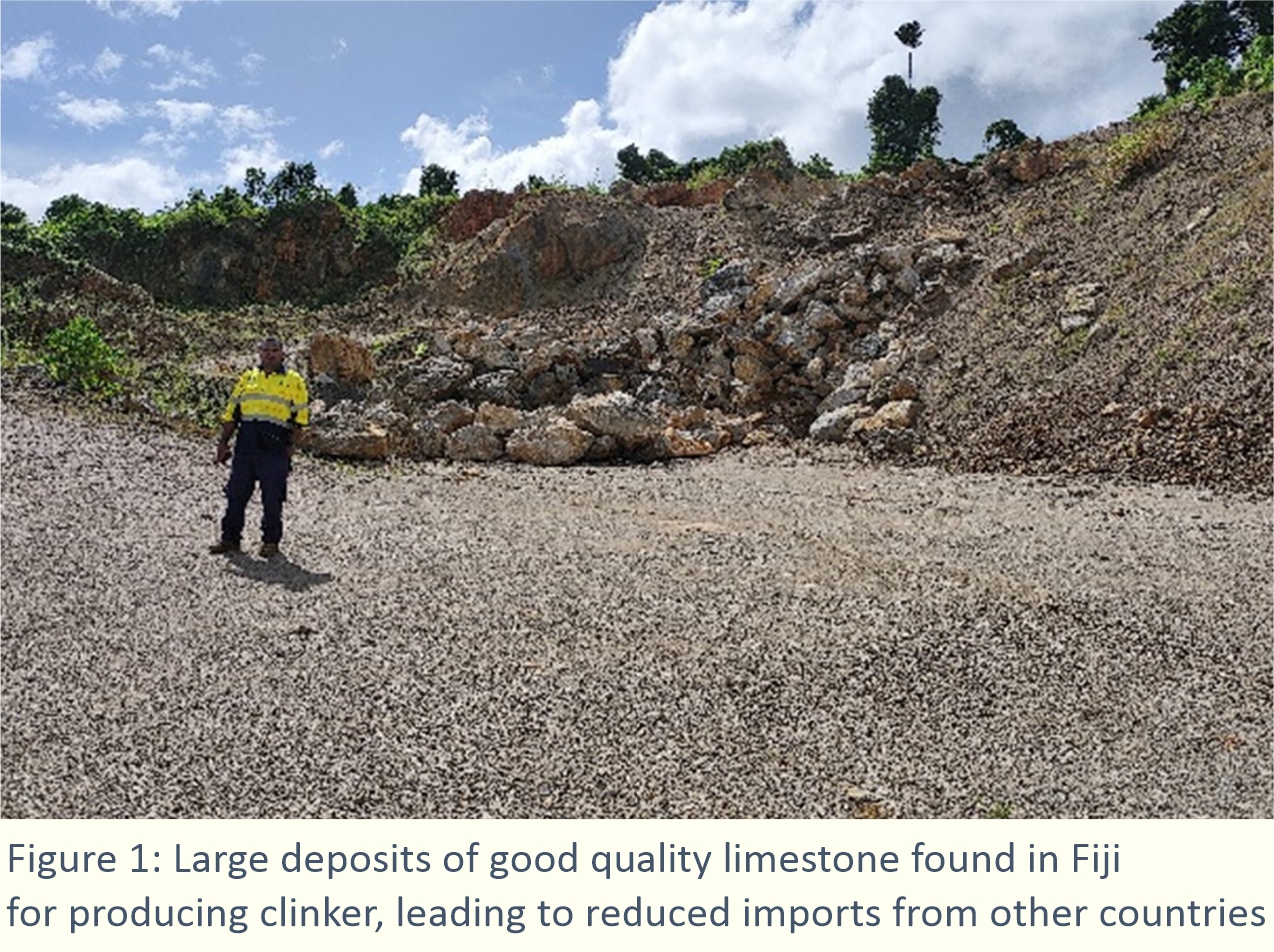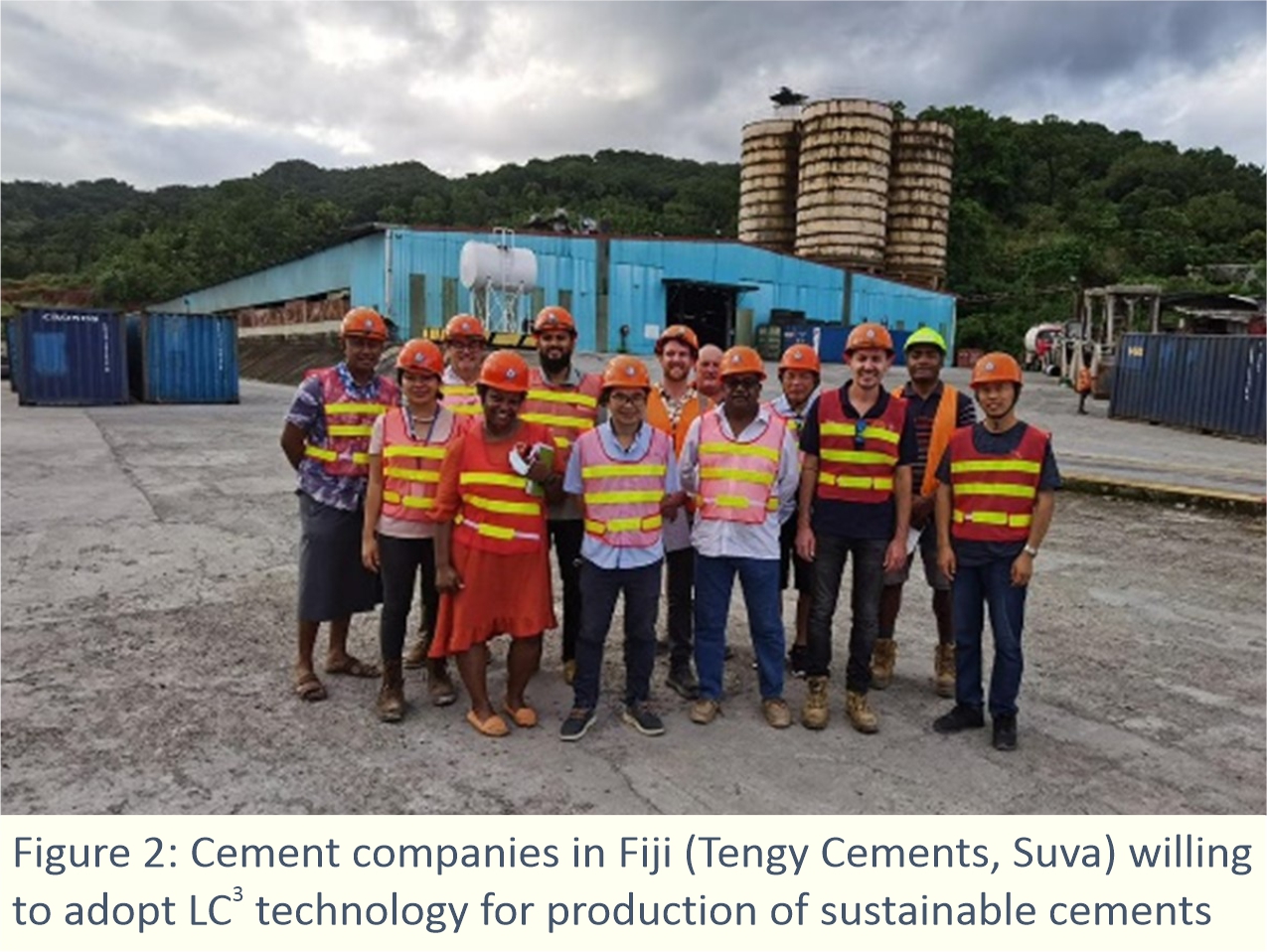|
Introduction of Low Carbon Cement in
Fiji and the Pacific Islands
T he
Pacific Small Island Developing States (PSIDS) is a group of 14 island
countries situated in the Pacific Ocean. Due to their geo-position and
small size, these countries are highly vulnerable to the effects of
global warming. These include a rise in sea level, saltwater intrusion,
and extreme weather events, which further impact the countries’
development. These island countries are devoid of any large production
facilities or power generation plants; thus, they are the smallest
contributors to global warming. Instead, they are the most vulnerable
due to their proximity to the sea and oceans. According to Fiji’s
National Climate Change Policy, the global sea level changes will more
than double by the end of this century (Secretariat of the Pacific
Community, 2012). Since 1993, Fiji has recorded a 6-millimetre (0.2
inch) increase in its sea level per year, which is larger than the
global average. The rapid rise in sea levels and the resulting saltwater
intrusion stemming from the increased ferocity of coastal floods have
converted portions of the island nations uninhabitable. Thus, the situation of these small island countries is extremely
critical and all efforts must be made to minimize the risk of climate
change and its resultant impacts. he
Pacific Small Island Developing States (PSIDS) is a group of 14 island
countries situated in the Pacific Ocean. Due to their geo-position and
small size, these countries are highly vulnerable to the effects of
global warming. These include a rise in sea level, saltwater intrusion,
and extreme weather events, which further impact the countries’
development. These island countries are devoid of any large production
facilities or power generation plants; thus, they are the smallest
contributors to global warming. Instead, they are the most vulnerable
due to their proximity to the sea and oceans. According to Fiji’s
National Climate Change Policy, the global sea level changes will more
than double by the end of this century (Secretariat of the Pacific
Community, 2012). Since 1993, Fiji has recorded a 6-millimetre (0.2
inch) increase in its sea level per year, which is larger than the
global average. The rapid rise in sea levels and the resulting saltwater
intrusion stemming from the increased ferocity of coastal floods have
converted portions of the island nations uninhabitable. Thus, the situation of these small island countries is extremely
critical and all efforts must be made to minimize the risk of climate
change and its resultant impacts.
 To support the transition of Fiji and PSIDS towards a low carbon
economy, various partners have joined hands together to build a ‘Blue
Economy’ transition. This is an initiative led by the Ministry of Land
and Mineral Resources, supported by the University of Queensland, the
Pacific Community, the United Nations Development Programme in Fiji, the
Indian Institute of Technology-Delhi, and Technology and Action for
Rural Advancement. The initiative will introduce limestone calcined clay
cement (LC3) in Fiji and support the adoption of ‘Blue Concrete’ through
the responsible sourcing of cement and aggregate. To support the transition of Fiji and PSIDS towards a low carbon
economy, various partners have joined hands together to build a ‘Blue
Economy’ transition. This is an initiative led by the Ministry of Land
and Mineral Resources, supported by the University of Queensland, the
Pacific Community, the United Nations Development Programme in Fiji, the
Indian Institute of Technology-Delhi, and Technology and Action for
Rural Advancement. The initiative will introduce limestone calcined clay
cement (LC3) in Fiji and support the adoption of ‘Blue Concrete’ through
the responsible sourcing of cement and aggregate.
LC3 is a ternary blended cement with clinker content as low as 50%. The
rest of the constituents are calcined kaolinitic clays, crushed
non-cement-grade limestone, and gypsum. The cement saves up to 40% of
CO2 emissions as compared to ordinary Portland cement. The only critical
component is the clay, which has 40% content of kaolinite. LC3 is a
general-purpose cement and is particularly beneficial in high chloride
environments, for example, coastal applications. This is of particular
importance to Fiji and PSIDS due to the region’s extensive coastline.
LC3 can be produced in existing cement plants and does not require any
high investment.
The technology is of particular importance to Fiji since the country is
also one of the main suppliers of cement to the PSIDS. The cement
industry in Fiji is smaller than in other countries. There are only two
companies that produce around 2 million tonnes per annum of cement,
which is used by the construction sector in Fiji and also exported to
PSIDS. It is expected that the introduction of LC3 in Fiji will not only
improve the disaster resilience of buildings within the country but also
enhance their lifespan by making houses and infrastructure more durable.
Presently, all the clinker in Fiji is imported. This not only increases
the price of cement but also drains the precious foreign exchange
reserve of the country. Thus, it is also expected that LC3 in the region
will reduce the cost of cement by around 40%, thereby making homes more
affordable and allowing a transition from current wood-based homes to
more sustainable concrete houses. Additionally, this will help
communities in the region adapt to climate change and the impacts of
extreme weather events.
Reference
Secretariat of the Pacific Community.
2012. Republic of Fiji National Climate Change Policy, Government of the
Republic of Fiji.
Dr. Soumen Maity
smaity@devalt.org
Back to Contents
|
 he
Pacific Small Island Developing States (PSIDS) is a group of 14 island
countries situated in the Pacific Ocean. Due to their geo-position and
small size, these countries are highly vulnerable to the effects of
global warming. These include a rise in sea level, saltwater intrusion,
and extreme weather events, which further impact the countries’
development. These island countries are devoid of any large production
facilities or power generation plants; thus, they are the smallest
contributors to global warming. Instead, they are the most vulnerable
due to their proximity to the sea and oceans. According to Fiji’s
National Climate Change Policy, the global sea level changes will more
than double by the end of this century (Secretariat of the Pacific
Community, 2012). Since 1993, Fiji has recorded a 6-millimetre (0.2
inch) increase in its sea level per year, which is larger than the
global average. The rapid rise in sea levels and the resulting saltwater
intrusion stemming from the increased ferocity of coastal floods have
converted portions of the island nations uninhabitable. Thus, the situation of these small island countries is extremely
critical and all efforts must be made to minimize the risk of climate
change and its resultant impacts.
he
Pacific Small Island Developing States (PSIDS) is a group of 14 island
countries situated in the Pacific Ocean. Due to their geo-position and
small size, these countries are highly vulnerable to the effects of
global warming. These include a rise in sea level, saltwater intrusion,
and extreme weather events, which further impact the countries’
development. These island countries are devoid of any large production
facilities or power generation plants; thus, they are the smallest
contributors to global warming. Instead, they are the most vulnerable
due to their proximity to the sea and oceans. According to Fiji’s
National Climate Change Policy, the global sea level changes will more
than double by the end of this century (Secretariat of the Pacific
Community, 2012). Since 1993, Fiji has recorded a 6-millimetre (0.2
inch) increase in its sea level per year, which is larger than the
global average. The rapid rise in sea levels and the resulting saltwater
intrusion stemming from the increased ferocity of coastal floods have
converted portions of the island nations uninhabitable. Thus, the situation of these small island countries is extremely
critical and all efforts must be made to minimize the risk of climate
change and its resultant impacts. To support the transition of Fiji and PSIDS towards a low carbon
economy, various partners have joined hands together to build a ‘Blue
Economy’ transition. This is an initiative led by the Ministry of Land
and Mineral Resources, supported by the University of Queensland, the
Pacific Community, the United Nations Development Programme in Fiji, the
Indian Institute of Technology-Delhi, and Technology and Action for
Rural Advancement. The initiative will introduce limestone calcined clay
cement (LC3) in Fiji and support the adoption of ‘Blue Concrete’ through
the responsible sourcing of cement and aggregate.
To support the transition of Fiji and PSIDS towards a low carbon
economy, various partners have joined hands together to build a ‘Blue
Economy’ transition. This is an initiative led by the Ministry of Land
and Mineral Resources, supported by the University of Queensland, the
Pacific Community, the United Nations Development Programme in Fiji, the
Indian Institute of Technology-Delhi, and Technology and Action for
Rural Advancement. The initiative will introduce limestone calcined clay
cement (LC3) in Fiji and support the adoption of ‘Blue Concrete’ through
the responsible sourcing of cement and aggregate.